Azulenoisoindigo:A building block for π-functional materials with reversible redox behavior and proton responsiveness
Bin Hou,Jing Li,Xiodi Yng,Jinwei Zhng,Hnshen Xin,Congwu Ge,Xike Go,*
a Key Laboratory of Synthetic and Self-Assembly Chemistry for Organic Functional Molecules,Shanghai Institute of Organic Chemistry,University of Chinese Academy of Sciences,Chinese Academy of Sciences,Shanghai 200032,China
b Experiment Center for Science and Technology,Shanghai University of Traditional Chinese Medicine,Shanghai 201203,China
ABSTRACT Azulene,one of representative nonbenzenoid aromatic hydrocarbons,exhibits unique molecular structure and distinctive physical and chemical properties.Herein,azulenoisoindigo(AzII),an azulene-based isoindigo analogue,is designed and synthesized,which has a twisted molecular backbone and R/Sisomers in single crystals.Interestingly,AzII shows the characteristics of both isoindigo and azulene,such as reversible redox behavior and reversible proton responsiveness.UV-vis-NIR,1H NMR and electron paramagnetic resonance(EPR)measurements were carried out to get insights into the possible mechanism of the proton-responsive property of AzII.The results demonstrated that only one azulenyl moiety of molecule of AzII was protonated and deprotonated,and the protonated AzII can be further oxidized to form azulenium cation radicals.
Keywords:Azulene Nonbenzenoid aromatic hydrocarbons Isoindigo π-Functional materials Proton responsiveness
Azulene,a typical bicyclic nonbenzenoid aromatic system,can be regarded as the fusion of an electron-rich five-membered ring and an electron-deficient seven-membered ring(Fig.1a).This nonalternant chemical structure distinguishes azulene from the isomeric naphthalene,which endows azulene with a bright blue color and a large dipole moment of 1.08 D[1].In addition,the highest occupied molecular orbital(HOMO)and lowest unoccupied molecular orbital(LUMO)of azulene are different from those of naphthalene,showing a non-mirror-related electron density distribution[2].This distinctive frontier orbital characteristics enable azulene with a small energy gap.Thanks to these unique structural and electronic configurations,azulene derivatives have been studied in functional organic materials[3–7]including sensory materials[8,9],Near IR(NIR)materials[10,11],organic field-effect transistors(OFETs)[12,13]and solar cells[14–16].In recent years,more and more attention has been paid to the azulene derivatives for their applications in responsive materials[17–21].To further explore new stimuli-responsiveπ-functional materials,it is imperative to develop new synthetic strategies for constructing novel azulene-based materials with proton responsiveness.
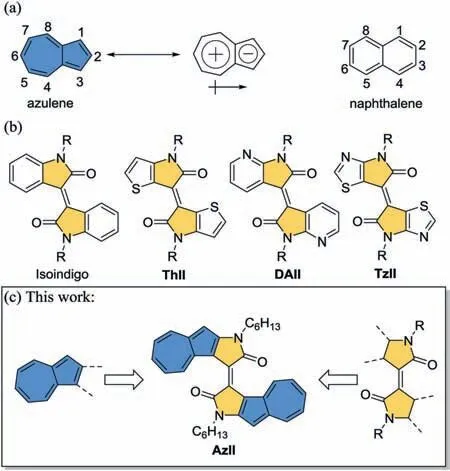
Fig.1.Molecular structures of(a)azulene and naphthalene with atom number,(b)representative isoindigo analogues and(c)AzII.
Isoindigo was identified as one of the most extensively studied moieties in antiproliferative agents[22,23]and optoelectronic materials[24–26].It has two five-membered lactam rings connected with an exocyclic double bond at the 3,3’-positions and each lactam ring is fused with a benzene ring to form a conjugated structure.Since Reynolds and coworkers[27]first investigated two isoindigo-based molecules in organic solar cells(OSCs)in 2010,isoindigo was soon widely applied as a building block to constructπ-functional materials[28,29].Moreover,to explore the optoelectronic property and performance relationships of isoindigo analogues,some strategies have been developed to optimize the molecular structures[26].Among them,one strategy is replacing the terminal phenyl rings with other aromatic rings.For example,the benzene rings were replaced by thiophene rings,pyridine rings and thiazole rings to form new isoindigo analogues,thienoisoindigo(ThII)[30],diazaisoindigo(DAII)[31–33]and thiazoloisoindigo(TzII)[34,35],respectively(Fig.1b).Through the molecular structure modification,the new isoindigo analogues perform even better optoelectronic properties than those of the intrinsic isoindigo.
In recent years,our group has devoted to the study of azulenebasedπ-functional materials[36–40].Herein we designed and synthesized a new isoindigo analogue,azulenoisoindigo(AzII),which combines the merits of azulene and isoindigo.As shown in Fig.1c,the two lactam rings of AzII are fused with azulene at its 1,2-positions.The structural features and optoelectronic properties of AzII were explored by experimental measurements and theoretical calculations.It is worth noting that AzII possesses protonresponsive behavior and would be a promising material used for sensors and other electronic devices.
The synthetic strategy of azulene-based isoindigo AzII is shown in Scheme 1.2-Chloroazulene(1)was prepared from commercially available tropolone according to the reported literature[41].Then compound 1 underwent Buchwald-Hartwig cross coupling reaction to affordN-hexylazulen-2-amine(2)in 88% yield.By reference to the synthesis of thienoisoindigo[42]with consideration of the high electrophilic aromatic substitution reactivity of 1-position in azulene,Friedel-Crafts acylation and amidation reaction of compound 2 with oxalyl chloride were performed with triethylamine in dichloromethane affording the azulenoisatin 3 in 31%yield,which is similar to Ito’s work[43];The self-coupling reaction of azulenoisatin 3 using Lawesson reagent gave the targeted compound AzII in 23% yield.AzII showed good solubility in common organic solvents,such as CH2Cl2,CHCl3,toluene and THF.The chemical structure of AzII was fully characterized with1H and13C NMR spectroscopy,high-resolution mass spectrometry,FT-IR spectrometry,elemental analysis,as well as single crystal analysis.The decomposition temperature of AzII was 302 °C defined as the 5%weight loss by a thermal gravimetric analysis(TGA),demonstrating the good thermal stability of AzII.
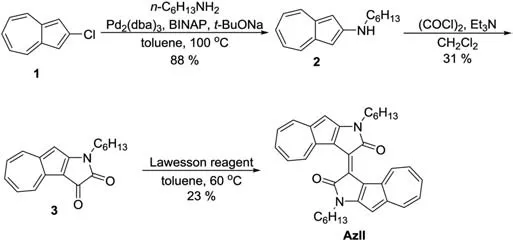
Scheme 1.Synthetic route of AzII.
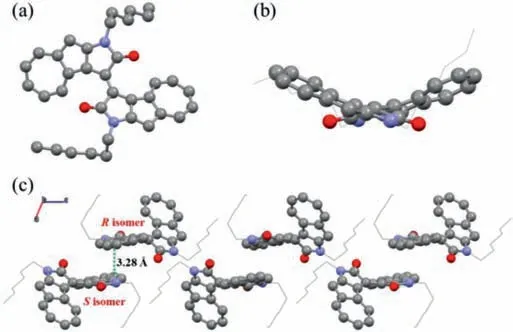
Fig.2.Crystal structure of AzII:(a)top view,(b)side view and(c)molecular packing.
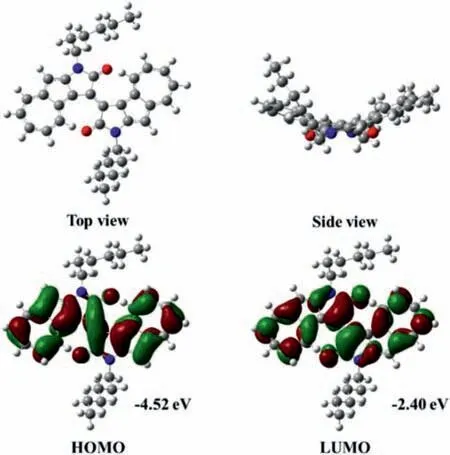
Fig.3.Optimized molecular structure,frontier molecular orbitals and energy levels of AzII obtained by DFT calculations.
Single crystals of AzII grown by a slow diffusion method with dichloromethane and methanol solvents were characterized by single-crystal X-ray analysis.The single crystal analysis shows that AzII has an obvious twisted molecular backbone(Fig.2).The dihedral angle of the two azulenyl moieties of AzII is 47.80°,which is larger than those of the previously described isoindigo analogues[44,45].It is noteworthy that there areR/Sisomers in the crystal,which is probably due to the intense steric hindrance between the O atoms of lactam groups and the neighbouring H atoms at 4-position of azulenyl units.Attempts to separate the isomers by chiral HPLC failed,maybe due to the inversion of configuration of AzII at room temperature.TheR/Sisomers of AzII form a dimer throughπ-πstacking,and the interplanar distance is about 3.29 ˚A between the mean planes of two azulene-fused rings and the short intermolecular atom-atom contacts are among 3.36–3.37 ˚A between the two molecules in the dimer.
To gain an insight into the molecular geometric structure and electronic properties of AzII,density functional theory(DFT)calculations were carried out at the B3LYP/6–31G(d,p)level using the Gaussian 16 Program.As depicted in Fig.3,the optimized molecular geometry of AzII is twisted,which is consistent with that in the single crystals.The electron density distributions of both HOMO and LUMO are widely delocalized and spread over the wholeπconjugated backbone.The calculated HOMO and LUMO energy levels of AzII are-4.52 and-2.40 eV,respectively.

Fig.4.(a)UV-vis-NIR absorption spectra of AzII in chloroform and in thin film,(b)cyclic voltammograms of AzII in dichloromethane(0.1 mol/L Bu4NPF6 as supporting electrolyte,SCE as reference electrode,scan rate of 100 mV/s).
The UV-vis-NIR absorption spectra and cyclic voltammetry(CV)of AzII were measured,and the related data are listed in Table S1.The UV-vis-NIR spectra of AzII in chloroform solution and in thin film are shown in Fig.4a.AzII exhibits the broad absorption bands in the visible region with the end peak maxima at 664 nm(ε= 25,500 L mol-1cm-1).The spectra of AzII in the thin film is red shifted with an end peak at 705 nm,demonstrating the increased intramolecular conjugation and intermolecularπ-πstacking in the thin film.The optical energy gap of AzII is calculated to be 1.60 eV from the onset of the end absorption in solution.The spectra of AzII are similar to those of other isoindigo analogues[44],indicating that the spectral features of AzII was dominated by parent isoindigo structure.
The electrochemical properties of AzII were investigated by CV in dichloromethane solution using 0.1 mol/L Bu4NPF6as the supporting electrolyte.As shown in Fig.4b,AzII presents two reversible reduction waves with the first and second half-wave potentials(φred1/2vs.SCE)at-0.98 and-1.35 V,respectively.In the positive potential region,there are also two reversible oxidation processes with the first and second half-wave potentials(φox1/2)vs.SCE of 0.53 and 0.78 V,respectively.The HOMO and LUMO energy levels of AzII estimated by CV(energy level of ferrocene was assumed to be-4.80 eVversusvacuum[46])are-4.89 and-3.38 eV,respectively.The resulting band gap(EgCV)is 1.51 eV,which is consistent with the optical bandgap(1.60 eV)with a deviation of 0.09 eV.
Conjugated polymers and small molecules containing azulene moieties are known to be sensitive to strong organic acids such as trifluoroacetic acid(TFA)owing to the protonation of 1-or 3-position of the azulene unit[17–21].To test the proton-responsive properties of AzII,TFA was added to its chloroform solution(Fig.5).The color of AzII solution changed obviously from sky blue to greyish green,which can be distinguished by naked eyes.The color immediately recovered after neutralization with triethylamine(TEA).To clarify the color change,the UV-vis-NIR absorption of AzII upon protonation with various volume ratios of TFA was studied(Fig.5).With the increase of volume ratios of TFA,the intensity of the absorption band at 664 nm decreased gradually.Meanwhile,a new band at 818 nm with a shoulder peak at 750 nm appeared,which was attributed to the protonation of AzII.When the TFA concentration was over 3%(v/v),the spectra did not change any more,suggesting the protonation state of AzII has reached saturation.While neutralizing with TEA,the UV-vis-NIR absorption(Fig.S2 in Supporting information)recovered almost without deviation,which is consistent with the color change observed by naked eyes.

Fig.5.Variations of UV-vis-NIR absorption spectra of AzII upon the protonation by TFA in chloroform.
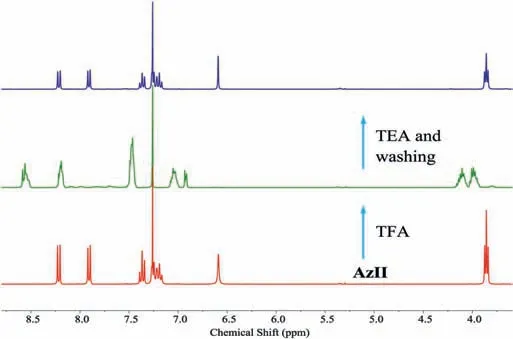
Fig.6.1H NMR spetra of AzII in CDCl3 by acid doping and base dedoping.
To further investigate the mechanism of the proton-responsive feature of AzII,1H NMR measurements of AzII in the neutral and protonated state were carried out.As shown in Fig.6,1H NMR spectrum of AzII was broadened at aromatic regions after adding excessive TFA,whereas the split is obvious in the neutral state.Importantly,the proton signal at 3.86 ppm assigned to the CH2group linked with the N atom became chemical shift nonequivalence upon protonation,indicating that perhaps only one azulenyl moiety of AzII was protonated in the presence of excessive TFA.When the acid-doped AzII was neutralized with TEA and washed with water,the1H NMR spectra of AzII recovered well to the initial state,demonstrating the reversible proton-responsive features of AzII.It is known that azulene derivatives are easily oxidized after protonation to form azulenium cation radicals.Thus,a study of electron paramagnetic resonance(EPR)was conducted with the neutral and TFA-protonated AzII in chloroform(Fig.S3 and Table S2 in Supporting information).Consequently,the AzII solution did not display any EPR signal in the neutral state,whereas a wellresolved symmetric signal with ag-factor value of 2.0022 and a peak-to-peak line width(ΔHpp)of 7.81 G appeared after the protonation of AzII in solution with TFA.The quantitative EPR experiment demonstrated that only about 2.1% of TFA-protonated AzII converted to azulenium cation radicals,thus the protonated AzII still showed good NMR signals and can be neutralized by TEA.These results are consistent with previous reports of azulene-based systems[17–21].As shown in Scheme S1,all results proposed that AzII possesses reversible proton responsiveness with only one azulenyl moiety of molecule protonated and the protonated AzII subsequently suffered from oxidation or charge transfer leading to cation radicals.This result demonstrates that AzII may be a potential building block for stimuli-responsive materials.
In conclusion,we have designed and synthesized an azulenebased isoindigo analogue AzII,which has a twisted backbone.DFT calculations,optical and electrochemical properties,as well as proton responsiveness of AzII were investigated.AzII integrates the properties of isoindigo and azulene,showing reversible redox behavior and proton responsiveness.The UV-vis-NIR,1H NMR and EPR measurements demonstrated that only one azulenyl moiety of molecule of AzII was protonated and deprotonated,and the protonated AzII can be further oxidized to form azulenium cation radicals.Our work sheds light on the significance of incorporating azulenyl moiety into classical conjugated system,and AzII would be a promising building block for novelπ-functional materials.Further studies of AzII-basedπ-functional materials are ongoing in our lab.
Declaration of competing interest
The authors declare that they have no known competing financial interests or personal relationships that could have appeared to influence the work reported in this paper.
Acknowledgment
This research was financially supported by the National Natural Science Foundation of China(Nos.21790362,22075310 and 21522209),the“Strategic Priority Research Program of Chinese Academy of Sciences”(No.XDB12010100),the Science and Technology Commission of Shanghai Municipality(Nos.19XD1424700 and 18JC1410600)and SIOC.An early preprint of this work appeared onChemRxiv[47].
Supplementary materials
Supplementary material associated with this article can be found,in the online version,at doi:10.1016/j.cclet.2021.08.079.
 Chinese Chemical Letters2022年4期
Chinese Chemical Letters2022年4期
- Chinese Chemical Letters的其它文章
- Key progresses of MOE key laboratory of macromolecular synthesis and functionalization in 2020
- Small nanoparticles bring big prospect:The synthesis,modification,photoluminescence and sensing applications of carbon dots
- Cell membrane-coated nanoparticles for immunotherapy
- Diketopyrrolopyrrole-derived organic small molecular dyes for tumor phototheranostics
- Exosome based miRNA delivery strategy for disease treatment
- Recent advances in targeted stimuli-responsive nano-based drug delivery systems combating atherosclerosis
